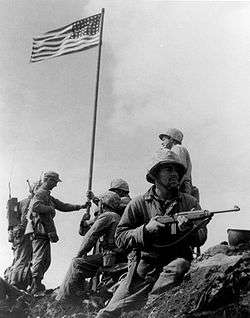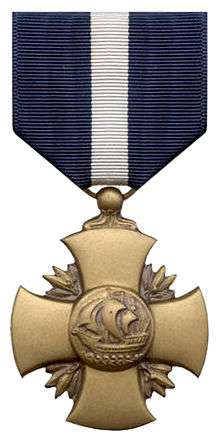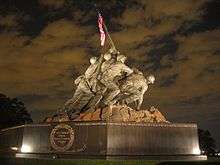Ernest Ivy Thomas, Jr.
| Ernest Ivy Thomas, Jr. | |
|---|---|
| Nickname(s) | Boots |
| Born |
March 10, 1924 Tampa, Florida |
| Died |
March 3, 1945 (aged 20) Iwo Jima |
| Allegiance |
|
| Service/branch | United States Marine Corps |
| Years of service | 1942–1945 |
| Rank | Platoon Sergeant |
| Unit |
2nd Battalion, 28th Marines, 5th Marine Division |
| Battles/wars |
World War II *Battle of Iwo Jima |
| Awards |
Navy Cross Purple Heart Medal Combat Action Ribbon |
Ernest Ivy "Boots" Thomas, Jr. (March 10, 1924 – March 3, 1945) was a United States Marine Corps platoon sergeant who was killed in action on March 3, 1945 during the Battle of Iwo Jima in World War II. He was posthumously awarded the Navy Cross for extraordinary heroism at the base of Mount Suribach on February 21. Thomas is best known for being one of the Marines who helped raise the first of two American flags atop Mount Suribachi on February 23, 1945.[1]
Early life
Ernest Thomas was born in Tampa, Florida, the son of Ernest and Martha Thomas. When he was a child, his family moved to Monticello, Florida.[2] He graduated from high school in Monticello and was attending Tri-State University in Angola, Indiana, studying aeronautical engineering, when he decided to enlist in the Marine Corps at Orlando, Florida.[3] Being color blind, in order to pass the medical test allowing him to enlist, he memorized the patterns provided by a man sitting next to him in the testing station.[4]
World War II
U.S. Marine Corps
Thomas enlisted in the Marine Corps on May 27, 1942. He completed "boot" camp at Parris Island, South Carolina and remained there as an instructor. Afterwards, he ("Boots Thomas") was an instructor at Camp Lejeune, North Carolina. In March 1944, he was assigned to E Company, 2nd Battalion, 28th Marine Regiment, 5th Marine Division at Camp Pendleton, CA. In September, his company was sent to Camp Tarawa in Hawaii to train with the 5th division for the Battle of Iwo Jima. In January 1945, the 5th division left for Iwo Jima.
Raising the flag on Iwo Jima

Left to right: 1st Lt. Harold G. Schrier (kneeling behind radioman), Pfc. Raymond Jacobs (radioman), Sgt. Henry "Hank" Hansen (soft cap, holding flagstaff), Pvt. Phil Ward (holding lower flagstaff, Platoon Sgt. Thomas (seated), PhM2c. John Bradley, USN (standing above Thomas holding flagstaff), Pfc. James Michels (holding M1 carbine), and Cpl. Charles W. Lindberg (standing above Michels).
On February 19, 1945, Thomas, a rifle company platoon sergeant with Third Platoon, E Company, 2nd Battalion, 28th Marines, landed on the southern beach towards Mount Suribachi with the first wave of Marines on Iwo Jima. On February 21, Thomas took over the command of the Third Platoon from his platoon commander who was wounded. Thomas and his men successfully assaulted a heavily fortified hostile sector at the base of Mount Suribachi which helped contribute to the eventual capture of Mount Suribachi on February 23 by Thomas's platoon. Thomas directed tank fire while under fire during the Marine assaults on the Japanese, and combined with his other heroic actions on February 21, he earned for himself the Navy Cross.[5]
On February 23 at 8 AM, First Lieutenant Harold Schrier,[6] the E Company executive officer, led a 40-man combat patrol with members mostly of Third Platoon, E Company up Mount Suribachi to seize and occupy the crest. Schrier was to raise an American flag to signal that the mountaintop was captured. Two Marines found a section of Japanese water pipe on top of the mountain that became the flagstaff for the flag. Lt. Schrier, Sgt. Henry Hansen, and Cpl. Charles Lindberg with the help of Thomas attached the flag to the pipe which was held by Pvt. Phil Ward (Thomas was ready with a grenade in hand in case any Japanese were to charge them out from caves). At approximately 10:20-10:35 a.m.,[7] Lt. Schrier, Platoon Sgt. Thomas, and Sgt. Henry Hansen raised the flag, planting the steel pipe into the ground.[8] Seeing the raising of the national colors immediately caused a reaction of loud victorious cheers with some gunfire from the Marines, sailors, and coast guardsmen on the beach below and from the men on the ships near the beach; the ships whistles and horns went off too.
It was determined by the Marines that a larger flag was needed to be seen more easily from the north side of Mount Suribachi where most of the Japanese soldiers were located and heavy fighting would occur in the days ahead. In the afternoon, the replacement flag was brought up Mount Suribachi by the Second Battalion's runner (messenger) for Easy Company followed by four Marines from Second Platoon, Easy Company, who were to raise this flag on top. The flag was attached to another Japanese pipe and raised and planted (as the other flagstaff came down) by the four Marines, the runner, and a Marine already on top who was a member of Schrier's 40-man patrol earlier.[9]
On February 24, Schrier ordered Thomas to report to the flagship USS Eldorado (AGC-11) the next morning, to meet with Vice Admiral Richmond K. Turner and Lieutenant General Holland Smith about the flag raising. After the interview with the two commanders, Thomas was interviewed by a CBS news broadcaster aboard ship, saying that Lt. Schrier, Sgt. Henry Hansen, and he, had actually raised the flag.[8] Thomas afterwards returned to his platoon which was still located on top of Mount Suribachi. On March 1, Sgt. Hansen was killed in action.
Death and burial on Iwo Jima
.ogg.jpg)
On March 3, Thomas was killed by enemy rifle fire on the north end of Iwo Jima opposite where Mount Suribachi is located on the island. Thomas was posthumously awarded the Navy Cross (for the February 21 action) and the Purple Heart Medal. He was buried on Iwo Jima at the 5th Marine Division cemetery.
On March 14, a flag was officially raised by orders of Lt. Gen. General Holland Smith on the north end of the island where 3rd Marine Division troops were located, and the second flag which was raised on February 23 on Mount Suribachi came down. A service was held At the 5th division cemetery on March 26, the morning of the day the battle was over and the 5th Division boarded Navy transports to leave Iwo Jima the next day.
In 1948, Thomas's body was returned to Monticello, Florida from Iwo Jima. He was buried at Roseland Cemetery in Jefferson County, Florida.[10][11]
Marine Corps War Memorial
The Marine Corps War Memorial (also known as the Iwo Jima Memorial) in Arlington, Virginia which was inspired by Rosenthal's photograph of the second flag-raising by six Marines atop Mount Suribachi on February 23, 1945, was dedicated on November 10, 1954.[12]Harold Schrier, Charles Lindberg, James Michels, and Lou Lowery, who were present at the first flag-raising on Mount Suribachi, attended the dedication.
President Dwight D. Eisenhower sat upfront with Vice President Richard Nixon, Deputy Secretary of Defense Robert Anderson, and General Lemuel C. Shepherd, the 20th Commandant of the Marine Corps during the dedication ceremony. Two of the three surviving flag-raisiers depicted on the monument, Ira Hayes and Rene Gagnon, were seated together with John Bradley (a Navy corpsman who was incorrectly identified as being a surviving flag-raiser)[13] in the front rows of seats along with relatives of the those who were killed in action on the island.[14] Speeches were given by Richard Nixon, Robert Anderson who dedicated the memorial, and General Shepherd who presented the memorial to the American people.[15] Inscribed on the memorial are the following words:
- In Honor And Memory Of The Men of The United States Marine Corps Who Have Given Their Lives To Their Country Since 10 November, 1775
Military awards
Thomas's military decorations and awards include:
- Navy Cross
- Purple Heart Medal
- Combat Action Ribbon
- Navy Presidential Unit Citation
- American Campaign Medal
- Asiatic-Pacific Campaign Medal with one 3⁄16" bronze star
- World War II Victory Medal
Navy Cross citation

The Navy Cross is presented posthumously to ERNEST I. THOMAS, JR., UNITED STATES MARINE CORPS RESERVE, for extraordinary heroism as a Rifle Platoon Leader serving with Company E, Second Battalion, Twenty-Eighth Marines, Fifth Marine Division, during action on enemy Japanese-held Iwo Jima, Volcano Islands, 21 February 1945. When his platoon leader was wounded, Platoon Sergeant THOMAS assumed command and, before supporting tanks arrived to cover him, led his men in an assault on a fanatically defended and heavily fortified hostile sector at the base of Mount Suribachi. With the tanks unable to proceed over the rough terrain beyond positions 75 to 100 yards at the rear of our attacking forces, Platoon Sergeant THOMAS ran repeatedly to the nearest tank, and in a position exposed to heavy and accurate machine-gun and mortar barrages, directed the fire of the tanks against the Japanese pillboxes which were retarding his platoon's advance. After each trip to the tanks, he returned to his men and led them in assaulting and neutralizing enemy emplacements, continuing to advance against the Japanese with a knife as his only weapon after the destruction of his rifle by hostile fire. Under his aggressive leadership, the platoon killed all the enemy in the sector and contributed materially to the eventual capture of Mount Suribachi. His daring initiative, fearless leadership and unwavering devotion to duty were inspiring to those with whom he served and reflect the highest credit upon Platoon Sergeant THOMAS and the United States Naval Service.
Other honors
A monument on U.S. Highway 90, Monticello, Florida, honors Thomas. It is inscribed with the following words:[2]
| “ | In recognition of Platoon Sergeant Ernest I. Thomas USMCR who on February 23, 1945, led his platoon to raise the first flag on Iwo Jima, the first Japanese territory taken in World War II. On March 3, eight days after the first flag raising and ten days after he earned the Navy Cross for heroism in action, he was killed leading his men in combat. March 10, 1924 - March 3, 1945. |
” |
Portrayal in film
In the 2006 film Flags of Our Fathers, Thomas was played by American actor Brian Kimmet.
Notes
- ↑ On February 23, 1945, the American flag was raised twice on Mount Suribachi. The smaller first flag was raised in the morning and captured on film by U.S. Marine photographer Staff Sergeant Louis R. Lowery. The iconic second flag raising occurred around noon and was captured on film by Associated Press photographer Joe Rosenthal. See Raising the Flag on Iwo Jima.
- 1 2 "Boots Thomas", Jefferson County.
- ↑ "TSU Remembers Thomas". Thunderbolt TSU Alumni Newsletter. April–May 2005. Retrieved 2007-01-17.
- ↑ Snowden, 2005
- ↑ Richmond News, Camden-Fleming man an unsung hero at Iwo Jima, January 2, 2012. Retrieved March 11, 2014
- ↑ Bradley, J. Powers, R. Flags of Our Fathers: Heroes of Iwo Jima.
- 1 2 Rural Florida Living. CBS Radio interview by Dan Pryor with flag raiser Ernest "Boots" Thomas on February 25, 1945 aboard the USS Eldorado (AGC-11): "Three of us actually raised the flag"
- ↑ USMC Statement on Marine Corps Flag Raisers, Office of U.S. Marine Corps Communication, 23 June 2016
- ↑ "Boots Thomas, Jr.", FindAGrave.
- ↑ Thomas grave and plaque
- ↑ Marine Barracts Washington, D.C.
- ↑ USMC Statement on Marine Corps Flag Raisers, Office of U.S. Marine Corps Communication, 23 June 2016
- ↑ "Memorial honoring Marines dedicated". Reading Eagle. Pennsylvania. Associated Press. November 10, 1954. p. 1.
- ↑ "Marine monument seen as symbol of hopes, dreams". Spokane Daily Chronicle. Washington. Associated Press. November 10, 1954. p. 2.
References
- "Boots Thomas and Raising the Flag on Iwo Jima". History and Culture. Jefferson County, Florida. Retrieved 2007-01-18.
- Snowden, LtGen. Larry (February 23, 2005). (Speech). Commemoration of the 60th Anniversary of the Battle of Iwo Jima, Marines Memorial Club and Hotel, San Francisco, California http://www.marineclub.com/Events/SpeechTranscripts/Transcripts.asp?speech=GenSnowdenSpeech. Retrieved 2007-01-17. Missing or empty
|title=(help).
- Marling, Karal Ann Marling and John Wetenhall (1991). Iwo Jima: Monuments, Memories, and the American Hero. Cambridge: Harvard University Press. ISBN 0-674-46980-1.
- "Navy Cross Awards to members of the U.S. Marines in World War II". HomeofHeroes.com. Archived from the original on 2006-08-28. Retrieved 2007-01-17.
- "Boots Thomas Jr.". FindAGrave.com. Retrieved 2007-01-17.
